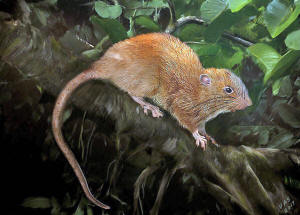|
After searching for it for years with cameras mounted in trees
and traps, scientists said they finally caught up with the rat
on Vangunu Island, part of the Solomon Islands, spotting one as
it emerged from a tree felled by loggers.
It instantly joined the list of the biggest rats in the world,
weighing about four times more than an ordinary rat and
measuring about 1-1/2 feet (about half a meter) long.
"Vika lives in a very thick, complex forest, and it is up in the
canopy so it is difficult to find. It is also a rare species. It
is likely there are not many of these rats left," mammalogist
Tyrone Lavery of the Field Museum in Chicago, who led the
research, said on Thursday.
The orange-brown rat dines on nuts and fruit, has short ears, a
smooth tail with very fine scales and wide feet that allow it to
move through the forest canopy.
The rat is reputed to chew holes in coconuts to eat the inside.
"I haven't found proof of this yet, but I have found that they
can eat a very thick-shelled nut called a ngali nut," Lavery
said.
A small number of rat species around the world rival vika's
size. Lavery said a vika relative also inhabiting the Solomon
Islands, called Poncelet's giant rat, is twice the size.
The world's largest rodent is not a rat, but rather South
America's barrel-shaped capybara.
A phenomenon called the "island effect" may help account for the
size of Vika and other big rat species in the Solomon Islands.
"The island effect, or island syndrome, relates to the effects
living on an island has on the evolution of body size. On
islands, small species such as rats, evolve to have larger body
size, they attain higher population densities and they produce
fewer offspring," Lavery said.
"Vika also probably arrived on an island where there were no
other large mammals living in the canopy eating fruits and nuts
so the species evolved to fill this niche," Lavery said.
Lavery said vika should be considered critically endangered,
with logging threatening its habitat.
The research was published this week in the Journal of
Mammalogy.
(Reporting by Will Dunham; Editing by Sandra Maler)
[© 2017 Thomson Reuters. All rights
reserved.] Copyright 2017 Reuters. All rights reserved. This material may not be published,
broadcast, rewritten or redistributed.

|
|






